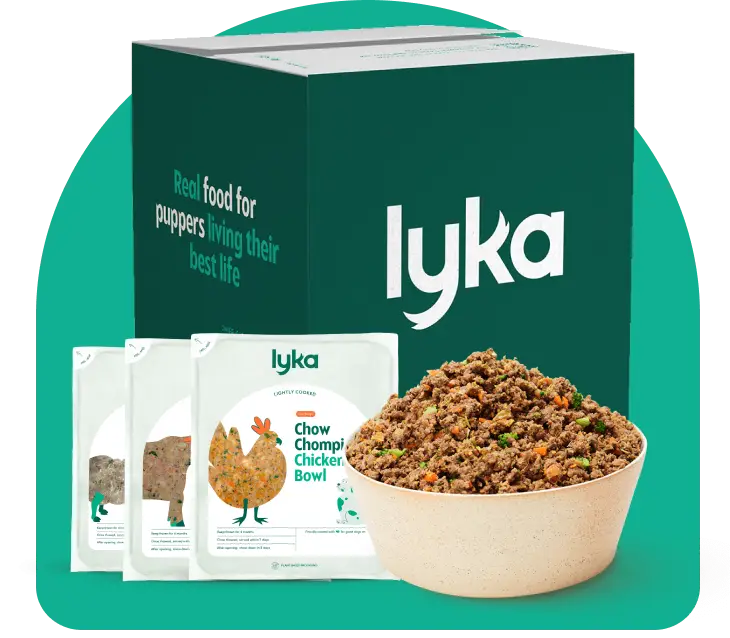The difference between Lyka and the ancestral diet for dogs

By Tara Wesson

Finding the best diet for your dog can feel overwhelming — especially when there are so many options to choose from. The truth is: there’s no single “best” type of diet, but it’s important to remember that wolves did have a varied diet of wholefoods: high in protein and low in carbohydrates.
Here’s where we draw from the ancestral diet at Lyka, and why we formulate our recipes the way we do.
A comparison of diets at a glance
The ancestral dog diet is made up of raw meat, bones and offal. This translates to a high protein, moderately high fat and low carbohydrate diet — minimally processed. These diets are not suitable for all dogs, and can make some pups sick. Your pup’s ancestors had much stronger microbiomes, which were able to handle raw meat.
Processed commercial dog foods are often higher in carbohydrates and lower in protein, following a broad ratio of 50% carbohydrates, 25% protein and 25% fat. This is because of its production methods — with grains and legumes creating that kibble texture.
How does Lyka compare?
Lyka’s wholefood recipes are high protein, moderate fat and low carbohydrate, with an average of 15% carbohydrates, 57% protein and 15% fat. Our highest protein recipe is kangaroo (67%), which also clocks in at just 9% fat — the leanest in our range. Our Fish Bowl has the most carbohydrates at 18%: just under half the commercial average!
Every recipe is free from high glycaemic index carbohydrates. We supply your dog with complex carbohydrates from human-grade vegetables and fruit.
Are our pups carnivores or omnivores?
Dogs prefer a carnivorous diet, but they can adapt to a variety of foods with ease. Your dog’s wild ancestors likely foraged on berries, herbs and mushrooms — plants containing conditionally essential nutrients (where the body generally produces enough).
While the jury is out on whether dogs are pure carnivores or omnivores, there’s a word for the modern-day dog’s penchant for protein and plants: carni-omnivores.
Wolves are foragers
Your pup begging for table scraps isn’t just a love for food: it’s an evolutionary trait.
The wolves that survived and passed on their genes were more docile and able to communicate with humans via a gaze (AKA those imploring puppy eyes). They were given extra table scraps as a result, leading to a more varied diet.
On a day-to-day level, wild dogs’ diet was not always perfectly balanced in the same way as your pup’s Lyka meals: but their diverse consumption would balance out over days and weeks, based on the availability of prey and plants. This included the stomach contents of small prey which fed on fruits and vegetables.
Wolves ate raw, so why is Lyka lightly cooked?
Lightly cooked diets remove the risk of potential pathogens and bacteria, as well as being easier to digest for many dogs. After meat, look for vegetable content at the top of the ingredients list. Wholefoods provide more bioavailable nutrients for your pup to unlock.
What does a species-appropriate diet mean at Lyka?
We avoid raw meat and bones for safety reasons, and cook our human-grade ingredients at only 90°C to increase nutrient absorption.
Blueberries, found in Lyka’s Lamb Bowl. When blueberries are lightly cooked, antioxidant content doubles. Antioxidants help to reduce inflammation – this goes for dogs as well as humans!
Carrots contain beta-carotene, which supports your dog’s immune response. This nutrient is easier for the body to absorb in a lightly cooked format. You’ll find these nutritious orange veggies in our Chicken, Beef, Turkey and Fish Bowls.
Tomatoes are lightly cooked in Lyka’s Kangaroo Bowl — your pup can take advantage of more polyphenols when exposed to heat.
The key advantage of wholefoods? Minimal processing means fewer ingredients being broken down. According to this study, this may mean higher concentrations of nutrients for your dog.
Wholefoods for the modern Aussie dog
Lyka recipes are as close as possible to a dog’s evolutionary diet: with nutritional ratios that domestic dogs instinctually consume. There’s no requirement for certain phytonutrients (like curcumin, found in turmeric) in the ancestral diet… but you’ll find them in every one of our recipes as a matter of standard.
AAFCO minimums set out the required level of nutrients a dog needs to survive — we want our pack to thrive. That’s why we pack Lyka meals to the brim with fruit, vegetables, superfoods, vitamins and minerals. Everything they need to live their best life.
Our classic meals are formulated by Dr Matthew Muir and a team of Board Certified Veterinary Nutritionists.
)






